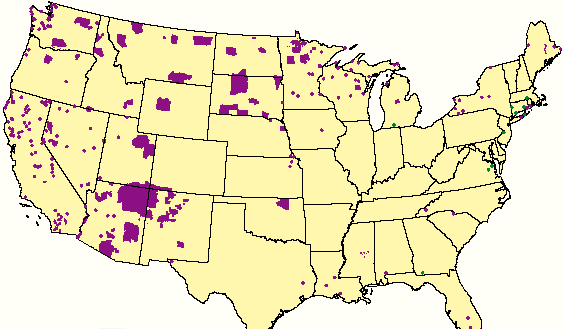History 3010
Self-Determination
Research a treaty between the U.S. and a particular Indian nation. Also research how that treaty figured in claims against the U.S.
Handout should include:
- short description of the treaty -- focusing on losses or gains for the tribe involved
- claims the tribe made against the U.S. for not fulfilling the terms of the treaty
- information about what the tribe did with the judgement
- citation of sources (must include citation for the actual treaty and court decision about the claim
Readings:
- Calloway Chpt. 7
- And: the treaty you are researching (Indian Affairs: Laws and Treaties, compiled by Kappler)
Indian Reservations Today


|
The Indian Reorganization ("Wheeler-Howard") Act
of 1934 was the keystone of the "Indian New Deal," the most
important turning point in federal policy toward American
Indians since the early nineteenth century. The New Deal
prescribed tribal constitutions, reversal of Bureau of Indian
Affairs (BIA) land policy, application of the First Amendment to
tribal religions, and reservation economic development and
social programs outside the control of the BIA. For the first
time in living memory, the BIA reservation superintendents began
to lose their positions as de facto colonial administrators with
almost total power over their charges. Some historians, both
Indian and non-Indian, have raised serious questions about the
effectiveness -- and sincerity -- of the reforms. It would,
nevertheless, be difficult to argue that the Wheeler-Howard Act
and the other measures of the Indian New Deal were not perceived
by many at the time as revolutionary or that its effects were
trivial.
|
Indian Claims Commission
On August 13th, 1946,
President Harry S. Truman signed into law the Indian
Claims Commission Act. Perhaps one of the most unique tools for
judicial intervention in history, this Act created a special
judicial body before which American Indian tribes could file
claims of all kinds against the United States government. Any
claim that any Indian tribe had against the United States,
extending back to the American Revolution, could be brought
before the Commission. In order to be valid, however, the
claims had to be brought within five years of the passage of the
Act. Any claims not brought before August 13th, 1951
would be forever barred by the statute. Despite the passage of
the deadline, claims that arose from
events prior to 1946 continue to be brought by Indian tribes.
Congress passed the ICCA in order to allow Indian tribes the
opportunity to “have their day in court,” but that day has long
since passed. The important goal of the Indian Claims
Commission has been largely forgotten or ignored, as courts
persist in allowing tribal suits. As Congress itself pointed
out, the purpose of the Act was to “bring this practice to an
end and to settle once and for all every claim [Indian tribes]
could possibly have under the categories set forth in the law.”
Today, a half-century later, the Act’s purpose still
stands unrealized. Indian Claims Commission Decisions
|
T